|
Looking back
Ancient Egypt:
A mighty empire
Those
of you who read the article on Sumer and Babylon we featured under this
series recently may have been fascinated with the lifestyles people led,
and the achievements they made during those ancient civilisations.
Today, we enlighten you on yet another great civilisation which was
built around the world's longest river, the Nile.
Mystery
still surrounds the origins, religion and monumental achievements of
this great empire, especially the pyramids of ancient Egypt. The world's
renowned archaeologists continue to unravel the mysteries of this
ancient land from time to time, with each new archaeological find they
make.
It is from
the various inscriptions, artefacts, mummies and documents discovered
during numerous excavation projects, that today we are aware of the
greatness of the Egyptian Empire and the valuable things they introduced
to the world, many of which are still used in more developed forms in
the modern world.
Birth of civilisation
It was on the banks of the mighty River Nile, which flows north from
the heart of the land into the
|
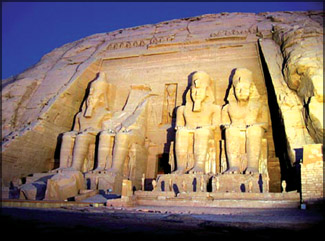
Temple of Abu Simbel |
Mediterranean Sea that the seeds of civilization were first
sown.
The flood plain was a magnet for life because, the mud deposited by
the river during the flood (silt) created the ideal conditions for
agriculture and the development of civilisation based on it.
The flood plain was called 'black land' and the rest of the land
(mostly desert area) was known as the 'red land'. Around 5000 BC,
nomadic groups moved into these areas and formed the first urban
settlement. As they concentrated mostly in the North and South of the
land, Egypt came to be known as a 'double land' or 'the two lands',
Upper and Lower Egypt.
In around 3100 BC, the Upper and Lower Egypt were united by the
legendary King Menes also known as King Narmer. A new administrative
city where the Nile branches out into the delta was established. It was
called white walls or Mennefer (the Greeks called it Memphis). It
remained the capital of Egypt for 3,500 years.
The Egyptian Empire grew over the years under different pharaohs and
dynasties from 3000 BC onwards. The reign of the pharaohs were grouped
into dynastic divisions which in turn was grouped into several periods,
starting with the Early period (3000-2575 BC) and ending with the
Greco-Roman Period (332 BC-AD 395). The Roman Empire annexed Egypt - as
a state in 31BC.
|
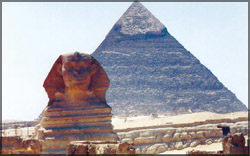
The Spynx and Pyramid of Giza. |
This long-standing civilisation in northeast Africa developed over
three and a half millennia around the fertile land of the Nile, which
was called 'the gift of the Nile' by a Greek traveller.
All levels of the population co-operated for the stability and fame
of Egypt. The government and religion were inseparable. The country was
headed by pharaohs who in the early years considered themselves to be
gods. However, this attitude changed later and the pharaohs were thought
of as divine representatives on Earth. Next to the pharaohs were
powerful officials who were known as viziers.
The land was divided into 42 districts for administrative purposes.
These districts were known as nomes or sepats in ancient Egypt.
Governors were appointed for each district. Taxes were imposed on people
and those who failed to pay them were punished.
Taxes in the form of grain, crops and animals were imposed because
there was no known currency until the 1st millennium BC.
The pharaohs who ruled the Empire owned everything in the land
including the people. The Empire grew and
|
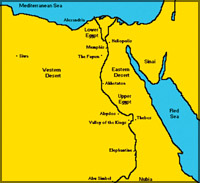
Map of ancient Egypt |
flourished under the reign of different pharaohs who governed
the land from time to time.
However, not all the pharaohs who ruled Egypt were Egyptians and
neither were they all men. Do you know that there were many women
pharaohs? Queen Maatkare Hatshepsut, Nefertiti and Cleopatra are three
rulers who are famous even today. The most important among them was
Queen Hatshepsut who ruled for a long period, from 1473 to about 1458
BC. She is believed to have been a strong ruler who often dressed as a
man, wearing even a false beard.
A mummy found sometime back was identified as that of Queen
Hatshepsut's by archaeologists. They claim that a molar tooth found
nearly a century ago had fitted in perfectly to the dental cavity of the
mummy which lay unidentified all this time.
There had been seven Egyptian Queens known as Cleopatra, but the most
famous of them all was Cleopatra VII. Queen Nefertiti was the wife of
King Akhenaton and they were sun worshippers. They worshipped Aten the
Sun God and forbade the people to worship any other god.
Religion and burial sites
|
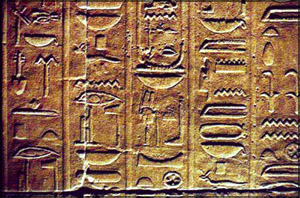
part of a hieroglyphics |
The pharaohs who were considered to be divine representatives were
very powerful and were treated with great reverence (respect mingled
with veneration) by the people.
As the Egyptians believed in life after death (and the pharaohs were
divine representatives), they were buried in imposing tombs built by
highly skilled engineers and architects.
All Egyptian pharaohs of the Old and Middle Kingdoms (3,500 to 5,000
years ago) were buried under pyramids.
The pharaohs of the New Kingdom were not buried in pyramids. They
were buried in tombs in the valley on the west bank of the Nile, at
Themes. The Egyptians were of the view that this was the Valley of Death
as the Sun set from this area.
The east bank, where the sun rose from was called the land of the
living and Egyptians built their homes on
|

Exquisite sculptures |
the east bank.By 1400 BC, the Egyptian Empire had developed
considerably. The Empire stretched from Syria to Africa.The Egyptians
were very religious.
In fact, religion played a key role in almost all activities,
including administration. However, religion was very much embodied in
Egyptian mythology. The Egyptians had a pantheon (a collection) of gods,
represented by even animals. The Sun was the most important and powerful
deity. Each district had their own special deity.
Agriculture and food
Ancient Egypt's civilisation developed based on agriculture. The
Empire grew along the River Nile because it was excellent farming land.
The Egyptians were highly skilled in developing irrigation systems to
grow crops in the fertile soil deposited during the floods.
Egypt was a land with hardly any rain, but by building tanks and
canals to store the water from the Nile when it flooded every July, the
Egyptian farmers were able to irrigate (water) their fields even in the
dry
|
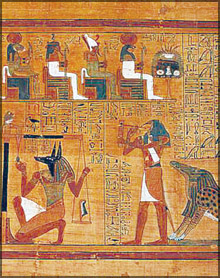
Art |
season. They also invented devices to irrigate their land.
The land was worked by peasants owned by the pharaohs. If they didn't
produce the quantities expected, they were punished.
Grain was one of the most important crops and it was used to pay
taxes, and was also exchanged for other goods. The farmers kept a
portion of the crop for their own benefit.Apart from grains, they
cultivated vegetables such as garlic, onions, leeks, beans, peas,
cabbage, and lettuce and fruits such as figs, grapes, melons,
pomegranates and dates. They also domesticated animals and raised pigs,
sheep and goat for food.
Grapes were processed into wine and was consumed mostly by the rich,
but beer was the favourite drink of the common man.
Bread was the main food for the poor Egyptians. Wheat and barley were
ground and mixed with water to make the dough for bread. They also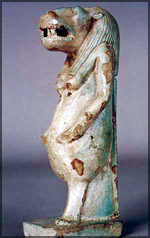 added flavourings such as garlic and honey to the dough and then baked
it in clay pots, which they had made out of the clay deposited by the
mighty Nile.
added flavourings such as garlic and honey to the dough and then baked
it in clay pots, which they had made out of the clay deposited by the
mighty Nile.
In fact, clay pots were very important because they were not only
used for cooking, but also to store water, oil, flour and beer. Baskets
and other types of containers were also made out of reed.
****
How pyramids were built
As we have mentioned earlier, pyramids were built as tombs for the
pharaohs, or kings as they were also known. In fact, the Great Pyramid
of Giza was built for King Khufu (c.2575BC) using over two million stone
blocks.
In general, it took at least 4,000 craftsmen and thousands of
labourers to build a pyramid. The labourers were mostly farmers who
worked as builders to pay off their taxes.
|
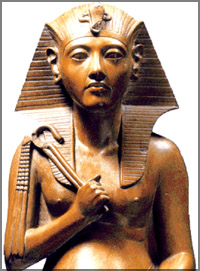
A Pharaoh |
The lands were cleared, the foundations laid and the stones were
dragged, without any aid (wheels, horses or tools) by the labourers who
worked under highly skilled architects and engineers.
The inside of the pyramid was built from soft stone found locally.
However, the limestone which covered the outside was brought from
quarries which were sometimes as far away as 800 kilometres.
Transportation was highly developed and the Egyptians had built
ships, even large boats, out of wood, complete with sails and oars.
Limestone for pyramids were transported in large barges. Huge blocks of
stone, sometimes weighing up to 50 tonnes, were loaded into them and
shipped to the building site during the flood season.
Once these huge stones were dragged into the construction site, stone
masons used an assortment of tools such as chisels and hammers and plumb
lines to cut these hard blocks of limestone into huge blocks that fitted
together perfectly.
The pyramids are not just a collection of these huge limestone
blocks, that were built in that shape to house the bodies of the dead
Pharaohs. They were built according to an elaborate architectural
design, with even a temple inside.
Altogether about 90 such pyramids were built, with the last one
constructed in 1570 BC. As it was easy for robbers to get into these
pyramids, the Pharaohs of the New Kingdom were buried in special tombs
carved in the cliffs in the Hidden Valley at Thebes and this area came
to be known as the Valley of Kings.
However, most of these tombs were also robbed, but the tomb of
Tutankhamun was discovered untouched by archaeologists Howard Carter and
Lord Carnarvon in 1922.
It lay hidden for over 3,000 years, and is considered as one of the
greatest archaeological discoveries. The discovery of Queen Hatshepsut's
mummy is also considered an important find.
Timeline
Some key dates in the development
of the civilisation.
5000 BC - People began farming in Nile Valley in Egypt
3200BC - Egyptian hieroglyphs fully developed.
3000 BC - Lower and Upper Egypt united under a single Pharaoh
3000 BC - Earliest known paper, papyrus were used
2700-2200 BC - Old Kingdom in Egypt; first step pyramids built.
2600 BC - Sphinx, the largest single stone statue, and Great Pyramids
were built.
1550-1050 BC - New Kingdom in Egypt, Valley of Kings used for Pharaohs'
tombs.
1500-1166 BC - Egypt at peak of power.
C.1000 BC - Kingdom of Kush in Africa began.
C. 750-682 BC - Kingdom of Kush defeated Egypt, Nubian rule over Egypt.
671-664 BC - Assyrians ruled Egypt.
525-404 BC - Persians ruled Egypt.
333-323 BC - Alexander the Great conquered Phoenicia, Egypt, Persia and
parts of India.
30 BC - Egypt taken over by the Romans.
Fact file
Egyptians may have the longest, continuous history of any people,
spanning over 7,000 years.
They were ruled by many over the years. They gained independence in
1922 and was declared a Republic in 1953.
The New Kingdom which lasted roughly from 1550 to 1070 BC is the
period that marked the rise of Egypt as an international power.
Ramesses II conducted many military campaigns and signed what may be
the world's first peace treaty. He constructed the renowned
archaeological complex - Abu Simbel.
Ramesses III was the last of the great Pharaohs of the New Kingdom.
The three periods that are considered most important are;
the Old Kingdom (3-6th
dynasties, 27th -22nd centuries BC about 2700-2200 BCE) capital Memphis
the Middle Kingdom (11th-14th
dynasties, 20th-17th centuries BC - about 2050-1800 BCE) the New Kingdom
(18th-20th dynasties, 16th-11 centuries BC - Graeco Roman period 332 BC
- AD 639)
The Narmer Pallet, perhaps the world's earliest known hieroglyphic
inscription was found in 1890 and is dated C.3150 BC. |
